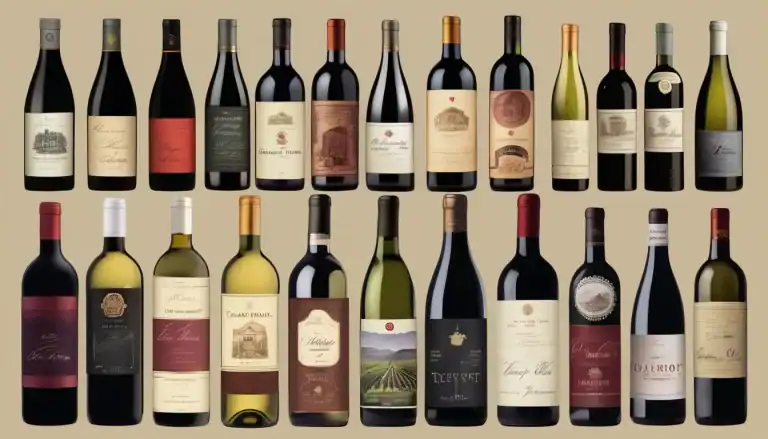Are you a wine enthusiast looking to protect your prized collection? You’re not alone! Did you know that 71% of wine collectors consider temperature control their top priority? It’s no wonder – improper storage can turn even the finest Bordeaux into vinegar faster than you can say “Cheers!”
But fear not, fellow oenophiles! I’ve spent countless hours (and maybe a few bottles) researching the best wine cellar cooling systems for home. Whether you’re a casual sipper or a serious collector, we’ve got the perfect solution to keep your vino in tip-top shape.
So, let’s pop the cork on this guide and dive into the world of wine cellar climate control!
Welcome to Didi Somm and Cheers!
Important Notice: The information in this article is for general and public information purposes only. It solely reflects Didi Somm’s or his Staff’s opinion, and no responsibility can be assumed for errors or omissions in the service’s contents. For details, please check the Disclaimer at the bottom of the homepage.
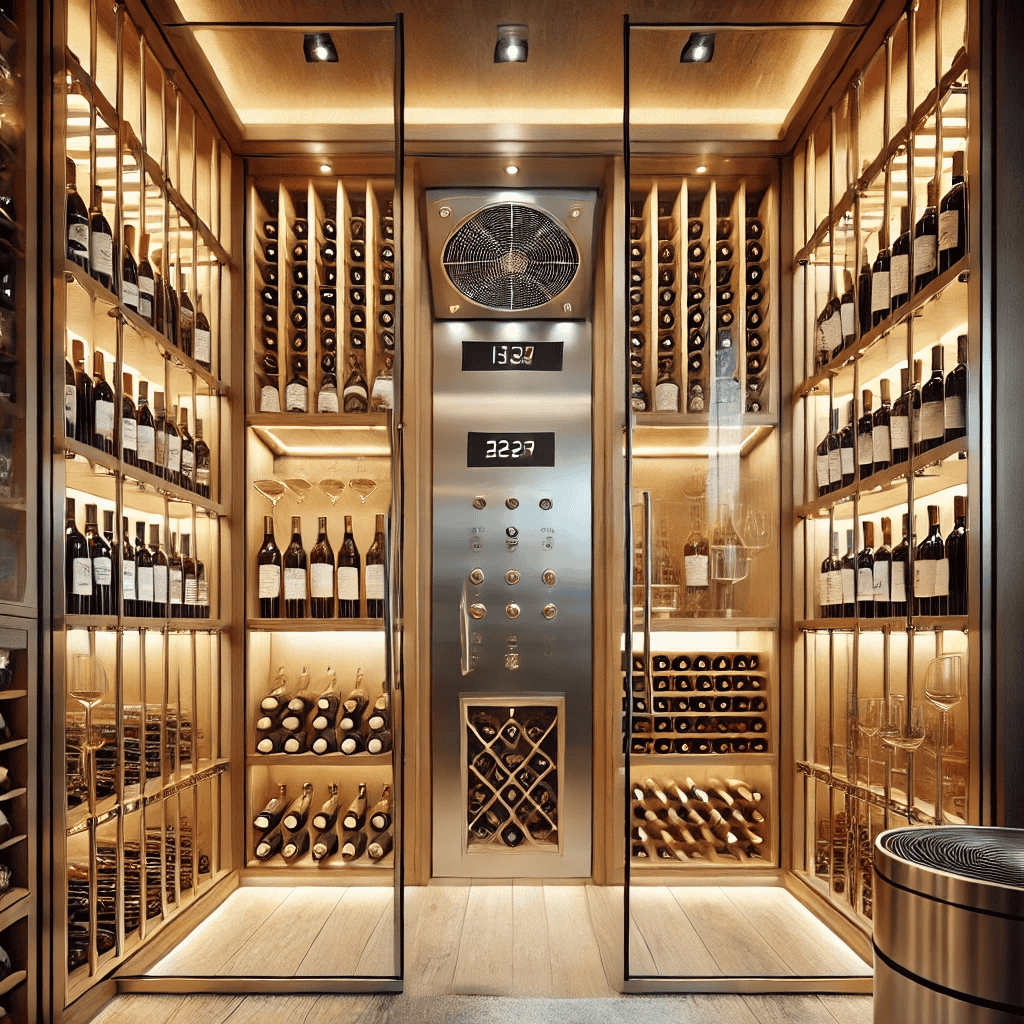
Key Takeaways
- Proper temperature control is crucial for preserving wine quality and aging potential
- Different cooling systems cater to various cellar sizes and configurations
- Energy efficiency is a key factor in choosing wine cellar cooling systems
- Installation complexity varies among different cooling system types
- Regular maintenance is essential for optimal performance and longevity of cooling systems
1. Through-the-Wall Cooling Units: The Space-Saving Champions
Let me tell you, when I first started getting serious about my wine collection, I was in a pickle. My “cellar” was basically a glorified closet, and I had no clue how to keep it cool without breaking the bank or tearing down walls. That’s when I stumbled upon through-the-wall cooling units, and boy, was it a game-changer!
These compact little powerhouses are perfect for small to medium-sized cellars. I remember the day I installed mine – it was like a DIY adventure. Sure, I might’ve watched the how-to video about 20 times, but hey, I got it done! The unit I chose could cool up to 1,000 cubic feet, which was more than enough for my modest collection.
One thing that really surprised me was how quiet these units can be. I was worried it’d sound like a jet engine, but it’s more like a gentle hum. My wife doesn’t even notice it when she’s reading in the next room. And let’s talk budget – these babies won’t force you to choose between a new cooling system and that case of Bordeaux you’ve been eyeing.
Pro Tip
Make sure you measure your space carefully before buying. I almost got one that was too powerful for my tiny cellar, which would’ve been like using a cannon to kill a fly. Also, don’t forget to factor in the thickness of your walls when planning the installation. Trust me, you don’t want to be stuck with a unit that’s too deep for your wall!
All in all, if you’re just starting out or working with a smaller space, through-the-wall cooling units are hard to beat. They’re efficient, relatively easy to install, and won’t break the bank. Just make sure you’ve got a steady hand with the power tools!

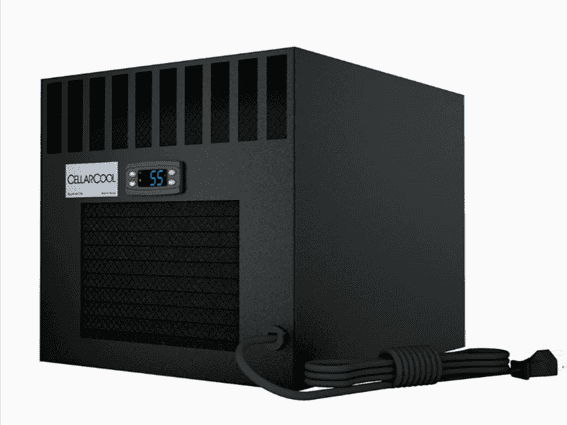
2. Split System Cooling: The Quiet Performers
Alright, wine lovers, let’s chat about split system cooling. When I upgraded from my closet-turned-cellar to a proper wine room, I knew I needed something with a bit more oomph. Enter the split system – and let me tell you, it was love at first chill.
The biggest selling point for me? The peace and quiet. See, these systems have two parts: the evaporator goes inside your cellar, while the noisy condenser sits outside. It’s like magic – you get all the cooling power without feeling like you’re living next to an airport runway. I remember the first night after installation, I kept checking to make sure it was actually on!
Now, I won’t sugarcoat it – installing a split system isn’t exactly a walk in the park. I hired a pro, and boy, was I glad I did. These systems are ideal for medium to large cellars, and they’re super flexible when it comes to installation. Got a weird layout or some tricky corners? No problem. My installer worked around my collection like a pro, ensuring every bottle stayed perfectly chilled.
One thing that really impressed me was the humidity control. My old unit left my corks drier than a bad joke at a dinner party. But with the split system, I can keep the humidity just right – between 50-70%. My corks are happy, and so am I!
Pro Tip
A fair warning: These systems aren’t cheap. But think of it as an investment in your liquid assets. The long-term efficiency more than makes up for the initial cost. Plus, your wines will thank you with better aging and more complex flavors. Trust me, once you go split, you’ll never look back!

3. Ducted Wine Cellar Cooling Systems: The Whole-House Heroes
Okay, fellow wine enthusiasts, let’s talk about the big guns – ducted cooling systems. When my collection outgrew my dedicated wine room and started taking over various nooks and crannies of the house, I knew it was time to go ducted or go home.
These systems are like the Swiss Army knives of wine cooling. They integrate with your existing HVAC system, which means you can keep multiple storage areas at the perfect temp without turning your home into a maze of wires and units. I’ve got bottles in the basement, the dining room, and even a small collection in the attic (don’t judge), and they’re all living their best life at a consistent 55°F.
The best part? No eyesores! Unlike other systems that stick out like a sore thumb, ducted cooling is practically invisible. My wine rooms look like, well, rooms. No bulky units, no noisy fans – just rows of beautiful bottles waiting to be enjoyed. It’s like having a secret superpower running through your walls.
Now, I’ll be honest – installing a ducted system is not a DIY job unless you’re some kind of HVAC savant. I hired a pro, and even then, it took a couple of days to get everything set up just right. But oh boy, was it worth it! The temperature control is so precise, I swear I can hear my wines singing with joy.
Pro Tip
One word of advice: plan ahead. If you think your collection might grow (and let’s face it, it always does), factor that in when sizing your system. I slightly underestimated and had to upgrade sooner than I expected. But now, with my whole-house hero in place, I’m ready for whatever wine adventures come my way!
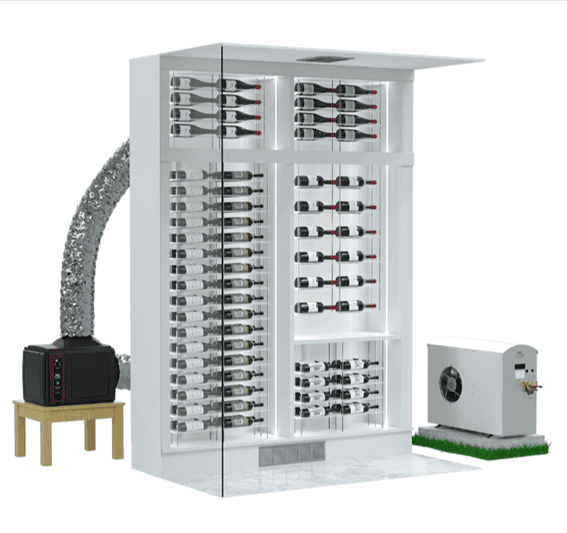
4. Self-Contained Cooling Units: The Plug-and-Play Solutions
Let’s get real for a second – not all of us have the space (or the budget) for fancy built-in wine cellar cooling systems. That’s where self-contained cooling units come in, and let me tell you, they’re a lifesaver for us everyday wine enthusiasts.
I remember when I first dipped my toes into the world of wine collecting. I was living in a tiny apartment, and the idea of installing a permanent cooling system was about as likely as me turning down a glass of Châteauneuf-du-Pape. That’s when I discovered these nifty plug-and-play units. It was like Christmas morning when I unboxed mine – no complicated setup, just plug it in and voila! Instant wine cellar.
These units are perfect for small wine rooms or closets. I started with a 30-bottle unit in my coat closet (sorry, coats), and it worked like a charm. The best part? When I moved to a new place, my little wine cooler came right along with me. No need to leave it behind or deal with complex uninstallation.
Now, I’ll be straight with you – these units aren’t going to win any beauty contests. They’re functional, not fancy. But for beginners or those of us with limited collections, they’re hard to beat. The upfront cost is way lower than other systems, which means more money for, you guessed it, wine!
Pro Tip
Pay attention to the temperature fluctuations in the room where you’ll keep your unit. I learned the hard way that placing mine next to a sunny window made it work overtime. Find a cool, shaded spot for best results. And don’t forget to clean the filters regularly – a little maintenance goes a long way in keeping your wines (and your electric bill) happy!
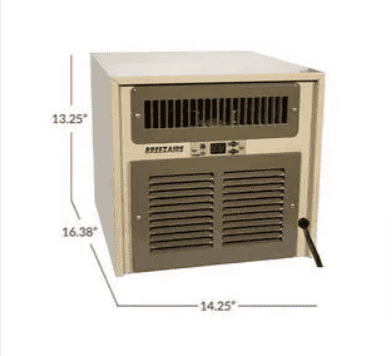
5. Innovative Cooling Technologies: The Future of Wine Storage
Buckle up, wine lovers, because we’re about to take a trip to the future of wine storage! When I first heard about these new-fangled cooling technologies, I was skeptical. I mean, my trusty old cooling unit was doing just fine, right? Wrong. Once I took the plunge into the world of innovative cooling, there was no going back.
First up, let’s talk about thermoelectric cooling. This isn’t your grandpa’s noisy compressor system. It uses some kind of science magic (okay, it’s actually the Peltier effect) to cool without any vibration. Why does this matter? Well, have you ever noticed how a fine wine can taste a bit off after a long car ride? That’s vibration at work, folks. With thermoelectric cooling, your wines can rest easy, undisturbed by mechanical vibrations.
But here’s where things get really cool (pun intended): smart climate control systems. Picture this: I’m on vacation in Tuscany (a guy can dream, right?), and I get a notification on my phone that the humidity in my cellar back home has dropped. With a few taps, I adjust it right back to the perfect level. It’s like having a personal sommelier watching over your collection 24/7.
And let’s not forget about the environment. These new systems often use eco-friendly refrigerants that are kinder to our planet. It’s a win-win – happy Earth, happy wines.
My favorite feature – Dual-Zone Cooling
My favorite feature is dual-zone cooling. I can keep my reds and whites at their ideal temperatures in the same unit. No more juggling different storage areas or compromising on temperature.
Now, I’ll admit some of these cutting-edge features can be a bit overwhelming at first. There was definitely a learning curve with my smart system. But trust me, once you get the hang of it, you’ll wonder how you ever lived without it. Just be prepared for your wine-loving friends to be very, very jealous!

FAQ – Wine Cellar Cooling Systems
- Q: What is the ideal temperature for a wine cellar? A: The ideal temperature for a wine cellar is generally between 55°F and 59°F (13°C to 15°C), with 55°F being optimal for long-term storage of most wines.
- Q: How often should I maintain my wine cellar cooling system? A: Regular maintenance should be performed at least twice a year, including cleaning filters, checking refrigerant levels, and inspecting for any wear or damage.
- Q: Can I install a wine cellar cooling system myself? A: Some systems, like through-the-wall units, can be DIY-installed. However, split systems and ducted systems typically require professional installation.
- Q: How much does it cost to run wine cellar cooling systems? A: Operating costs vary depending on the system size and efficiency but generally range from $30 to $100 per month in electricity costs.
- Q: What size cooling system do I need for my wine cellar? A: The size depends on your cellar’s volume, insulation, and ambient temperature. A general rule is 1 BTU of cooling per cubic foot of space.
- Q: Are there eco-friendly options for wine cellar cooling systems? A: Yes, many modern systems use eco-friendly refrigerants and energy-efficient technologies to reduce environmental impact.
- Q: How loud are wine cellar cooling systems? A: Noise levels vary, with through-the-wall units being louder (50-60 dB) and split systems quieter (40-50 dB). Self-contained units fall in between.
- Q: Can I use a regular air conditioner for my wine cellar? A: Regular AC units are not recommended as they don’t provide the consistent temperature and humidity control needed for proper wine storage.
- Q: How important is humidity control in a wine cellar? A: Very important. Ideal humidity levels (50-70%) prevent cork drying and mold growth. Most wine-specific cooling systems include humidity control.
- Q: What’s the lifespan of typical wine cellar cooling systems? A: With proper maintenance, most systems last 10-15 years. Higher-end systems may last up to 20 years.
- Q: Can I cool multiple wine storage areas with one system? A: Yes, ducted systems can cool multiple areas, and some split systems offer multi-zone cooling capabilities.
- Q: Are there cooling systems for outdoor wine cellars? A: Yes, there are specialized outdoor-rated cooling units designed to withstand various weather conditions.
- Q: How do I know if my cooling system is working properly? A: Monitor temperature and humidity levels regularly. Consistent readings within the ideal range indicate proper function.
- Q: Can cooling systems handle temperature fluctuations in my home? A: Quality systems are designed to maintain stable cellar temperatures despite ambient temperature changes, but extreme fluctuations may impact performance.
- Q: Are there any tax incentives for installing a energy-efficient wine cellar cooling systems? A: Some energy-efficient systems may qualify for local or federal tax incentives. Check with a tax professional or local utility company for current offers.
Conclusion
There you have it, wine lovers – the crème de la crème of wine cellar cooling systems! Whether you’re safeguarding a few special bottles or a vast collection, there’s a perfect cooling solution waiting to protect your liquid investments.
Remember, a well-maintained cellar is the key to unlocking the full potential of your wines. So why wait? Take the plunge and create the perfect environment for your vino to thrive. Trust me, your future self (and taste buds) will thank you.
Now, if you’ll excuse me, all this talk of wine has made me thirsty. Cheers to perfectly chilled wines and the amazing memories they help us create!
For your reference, the latest articles by Didi Somm include:
- 10 Best Space-Saving Wine Cellar Ideas for Compact Homes in 2024
- 15 Stunning Home Wine Cellar Designs to Inspire Your Next Project
- Best Home Wine Cellars 2024: The Ultimate Buyer’s Guide
- Home Wine Cellar Construction: A Beginner’s Guide (2024)
- DIY Wine Cellar vs. Professional Installation: What’s Best for You in 2024?
- 5 Best Wine Cellar Inventory Software in 2024 – Get Expert Advice Here!
Important Notice: The information in this article is for general and public information purposes only. It solely reflects Didi Somm’s or his Staff’s opinion, and no responsibility can be assumed for errors or omissions in the service’s contents. For details, please check the Disclaimer at the bottom of the homepage.




